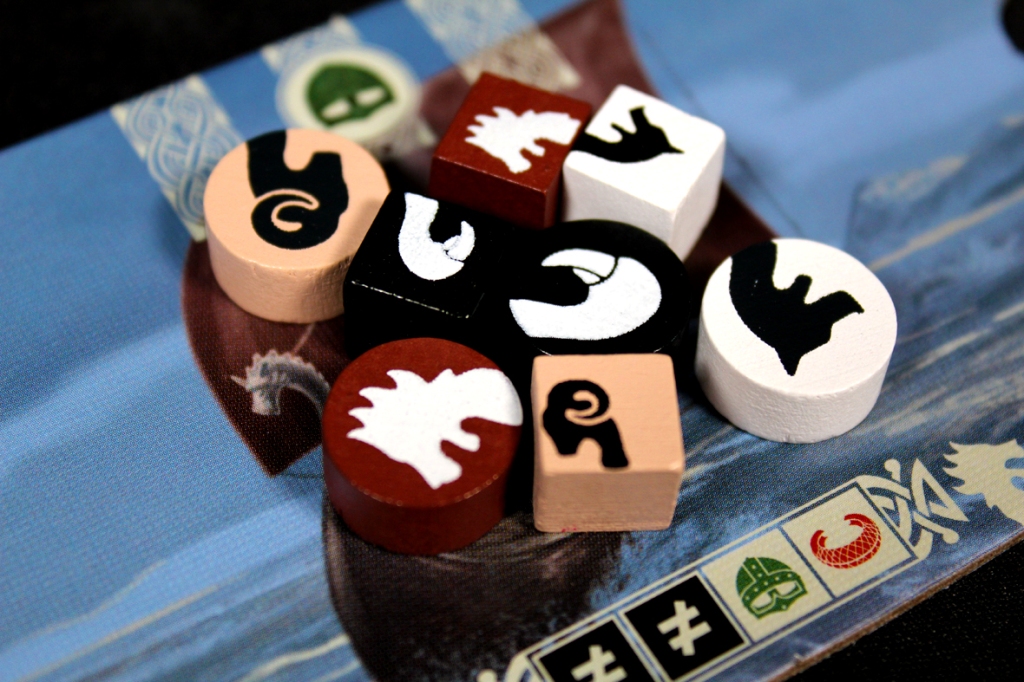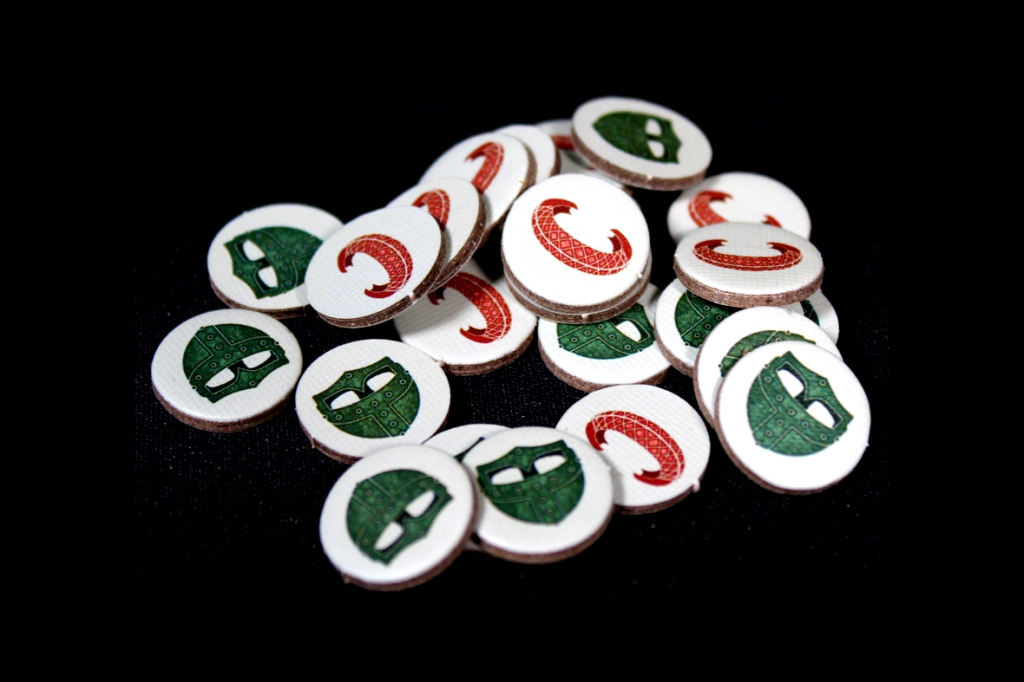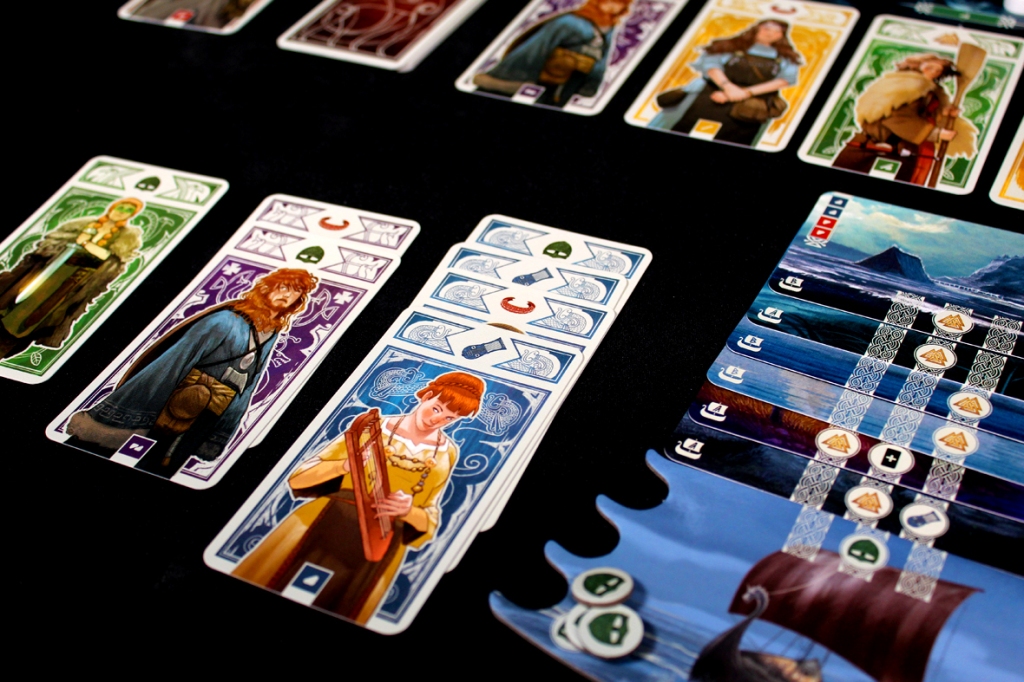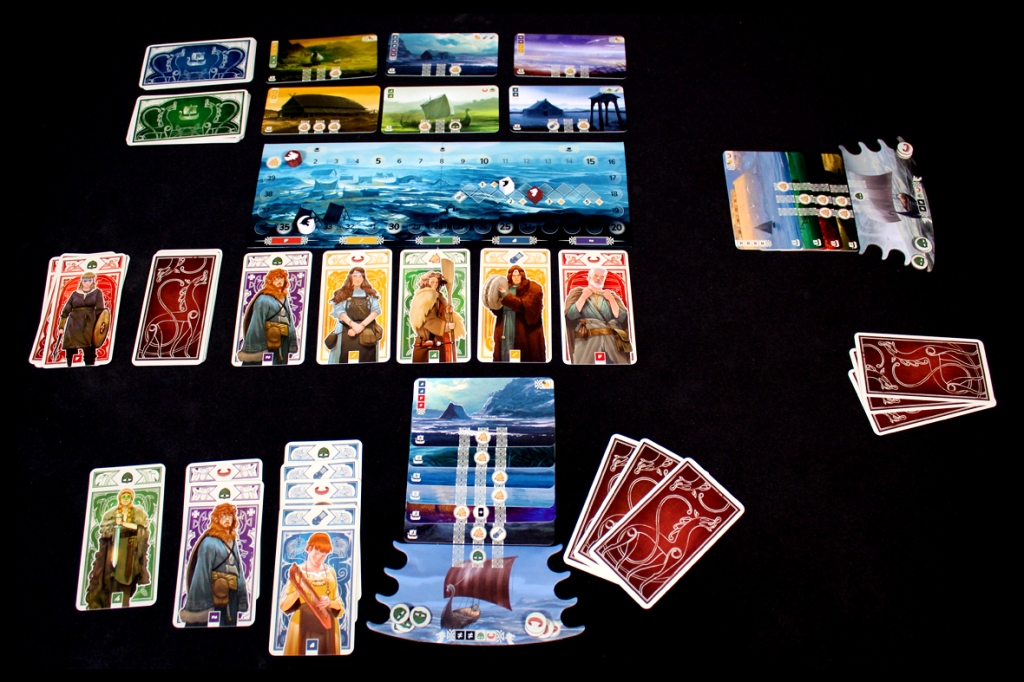
Base price: $30.
2 – 4 players.
Play time: ~30 minutes.
BGG Link
Buy on Amazon (via What’s Eric Playing?)
Logged plays: 7
Full disclosure: A review copy of Knarr was provided by Pandasaurus Games.
Whoops, I got behind again. Another day, another dollar, I suppose, but here we are. This time I’m doubly behind because I really need to get back on top of reviews before I head on my little vacation next weekend, but I’m working on that and some crowdfunding previews, even! Get hyped for those. Lots of depth to plumb in the near future. I do have a list, this time, so I’ll be holding myself to progress and process over the next few weeks. That’s probably exciting. In the meantime, let’s talk Knarr, from Pandasaurus Games!
In Knarr, players take on the role of a leader of a band of Vikings. As you send them to various destinations and recruit new folks to your crew, you’ll gain various resources, improve your reputation, and increase your influence. How will you lead, and will you become the greatest among the Vikings?
Contents
Setup
Not a ton of setup, which is pretty nice. You can start by placing the board in the center of the play area:

Next, shuffle the Trading Lands and Lands of Influence [Destination] cards:

Make a row of three of each type above the board. Then, each player should get a player board of their choice:

There are player tokens in each color. The round tokens are for tracking scoring, and the square ones are for tracking Reputation.

Place them on the relevant zero spaces. Give each player three Recruit tokens and three Silver Bracelet tokens. You’ll start with one of each.

Finally, shuffle the Viking Cards (removing the 3s and 4s if you’re playing with fewer players) and deal each player two cards of a different color. Then place five cards face-up, one below each column.

Deal each player three Viking Cards to form their starting hand. For advanced play, use an Artifact:

You should be ready to start!

Gameplay

This one’s not too tough. Over the course of several rounds, each player performs one action on their turn, and then optionally trades in bracelets.
On your turn, first, gain points based on your Reputation. If it’s on or past a certain point marker, gain that many points.
Then, you can either Recruit or Explore. To Recruit, play a card from your hand to your crew area and gain the resource indicated on the card. If you place a card of a color you currently have in your crew area, gain the resources indicated on all cards of that color. Pretty neat. Then, draw a card from the column of the same color as the card you played, or spend a Recruit Token to draw from any column.

To Explore, choose one of the Destination cards and spend the matching cards to purchase it, adding it to the top of your player board. Recruit Tokens can be used as cards of any color. Once you do, gain the points and / or resources on the top right of the card.
Either way, at the end of your turn you can spend 1 / 2 / 3 bracelets to gain the resources pictured on the first / first and second / first, second, and third columns on and above your player board. Trading!

After one player gets 40 points, the game ends as soon as every player has taken an equal number of turns. The player with the most points wins!
Player Count Differences

Not an extreme amount here beyond the usual. You’ve got a random market both of Viking Cards and Destination Cards, so you’re going to see a bunch of entropy there at higher player counts. This usually is balanced out by more cards of each color at higher player counts, but that also means you can experience more variance. Namely, you can have big chunks of that market stuck with only one color of Viking Cards. Not necessarily ideal, especially if one person is just using them to chain effects. Beyond that, though, it’s a question of how much entropy you can tolerate. There’s no real take-that beyond me aggressively going after a Destination or Viking Card that you want, and even then there’s no guarantee that that will actually slow you down or stop you. I do like this game a lot at two, though; it’s quite snappy. I wouldn’t have a problem with more players though, either.
Strategy

- Recruiting is great, if you can stack enough of the same color cards. You can really double down on those bonuses, especially if you’re leaning into Reputation. Leaning into Recruits is nice for a bit but you really want to be spending those with relatively high frequency (you don’t get points for them at the end of the game).
- Don’t forget to actually Explore! That’s where you get a lot of points. You want to get some of those higher-value Destinations to stay in the game; even a bunch of Reputation won’t necessarily beat those 9 point cards (though it’ll certainly help).
- Reputation can be a pretty sterling bonus if you get enough of it. I had a game where I was getting 3 points every turn off of Reputation; that’s kind of wild for this game, especially since the point cap to end the game is 40. That’s without doing anything else. Add in Destination Cards and I was rolling in it.
- A critical part of Exploring is building up your trade routes for when you trade bracelets. I usually do that to farm Reputation or gain additional cards, but they’re a useful source of Recruits and Points, too, if you get the right cards.
- Extra recruits are generally useful! Good to have. If you have three, you should be spending them on something, though.
- While there are a finite number of cards of each color, I’m not sure it pays to be keeping intense track of what your opponent is playing. You can strategize as much as you want, but the only thing worth really noting is whether or not you think your opponent is going after the cards you want.
Pros, Mehs, and Cons

Pros
- I really like the foreword on the front of the rulebook! It’s odd, in some ways, since it means the rulebook doesn’t have the name of the game on the front, but beyond that, it’s really cool to see a game that takes a historical culture and people and provides context that’s not just reductionist dramatized history. Lucie Malbos does a great job in the foreword, also; it’s a nice thought on the game before you start playing. I’d love for this to be like, the minimum for games moving forward. It’s sharp, and the game feels better for being more authentic.
- The art style is very pleasant, as well. I particularly like the Destination Cards, but the Viking Cards are striking in their own right. They do a great job of making the wide variety of ages presented all look regal and impactful in their own way. I’m definitely a fan.
- It’s a pretty straightforward card game, which is nice. You can pick this one up pretty quickly; no tricky rules until you start folding in the artifacts.
- Oh, it’s nice that they have packets for the sets of cards. It’s just nicer than bags (and likely a lot more eco-friendly than plastic, though who knows if the holders are plasticized). Makes the game look better, as well.
- Plays pretty quickly, too. Very short game once everyone knows how to play! There aren’t a lot of decisions, but the decisions themselves are interesting.
- I think, generally, Bombyx has been doing really well on quick and simple card games, lately; I’m glad Pandasaurus has brought several of them over. I’m, of course, enamored with Sea Salt & Paper, but there are a lot of great little games from Bombyx and this is another solid one.
Mehs
- While it’s obviously necessary to have the cards and the recruiting columns be the same color, it can make the game a bit tough to explain. It’s just a little amusing hiccup when you say “you can take the red card” and players think you mean the card in the red column when you mean the actual red card (or vice-versa; both have happened to me).
Cons
- A lot of the icons on the cards are pretty small, so they can be hard to read at times. They’re just very tiny and in the corners; larger would be nice, though I respect the desire to let the card art take center stage since it looks so good.
Overall: 8.5 / 10

Overall, I think Knarr is great! Like I was saying earlier, Bombyx has been firing on all cylinders when it comes to short and snappy card games, and Pandasaurus has been wise to bring a lot of them stateside. These distribution deals are good for everyone, probably, I said, as someone who understands literally nothing about importing or distribution. But I digress. Knarr is one of those games that after you play it a few times, everyone knows the rules and it becomes one of those games you just lazily play over and over not just because it’s easy, but because it’s fun. Close games, new strategies, dealing with the random hands you’re dealt; it’s all great. I do wish the icons on the cards were a bit bigger, but honestly, if that’s my biggest complaint about a game, it’s got to be pretty solid. I’ve been enjoying Knarr both on and off of Board Game Arena. Low setup, low complexity, and I can teach it to anyone and bring it just about anywhere. I’m always excited to see what Bombyx is bringing to the table, and this is another good one! Worthy of being in the same thought as Sea Salt & Paper (though I’m a bit more obsessed with that one, sitting at ~180 plays or so). If you’re looking for a great little card game, you’re wanting to find a game you can teach to just about anyone, or you just want to live your Viking dreams, I’d recommend taking Knarr for a spin! I think it’s quite fun.
If you enjoyed this review and would like to support What’s Eric Playing? in the future, please check out my Patreon. Thanks for reading!